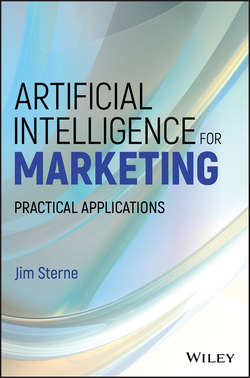Читать книгу Artificial Intelligence for Marketing - Sterne Jim - Страница 17
На сайте Литреса книга снята с продажи.
CHAPTER 1
Welcome to the Future
ARE WE THERE YET?
ОглавлениеMost of this sounds a little over‐the‐horizon and science‐fiction‐ish, and it is. But it's only just over the horizon. (Quick – check the publication date at the front of this book!) The capabilities have been in the lab for a while now. Examples are in the field. AI and machine learning are being used in advertising, marketing, and customer service, and they don't seem to be slowing down.
But there are some projections that this is all coming at an alarming rate.12
According to researcher Gartner, AI bots will power 85 % of all customer service interactions by the year 2020. Given Facebook and other messaging platforms have already seen significant adoption of customer service bots on their chat apps, this shouldn't necessarily come as a huge surprise. Since this use of AI can help reduce wait times for many types of interactions, this trend sounds like a win for businesses and customers alike.
The White House says it's time to get ready. In a report called “Preparing for the Future of Artificial Intelligence” (October 2016),13 the Executive Office of the President National Science and Technology Council Committee on Technology said:
The current wave of progress and enthusiasm for AI began around 2010, driven by three factors that built upon each other: the availability of big data from sources including e‐commerce, businesses, social media, science, and government; which provided raw material for dramatically improved Machine Learning approaches and algorithms; which in turn relied on the capabilities of more powerful computers. During this period, the pace of improvement surprised AI experts. For example, on a popular image recognition challenge14 that has a 5 percent human error rate according to one error measure, the best AI result improved from a 26 percent error rate in 2011 to 3.5 percent in 2015.
Simultaneously, industry has been increasing its investment in AI. In 2016, Google Chief Executive Officer (CEO) Sundar Pichai said, “Machine Learning [a subfield of AI] is a core, transformative way by which we're rethinking how we're doing everything. We are thoughtfully applying it across all our products, be it search, ads, YouTube, or Play. And we're in early days, but you will see us – in a systematic way – apply Machine Learning in all these areas.” This view of AI broadly impacting how software is created and delivered was widely shared by CEOs in the technology industry, including Ginni Rometty of IBM, who has said that her organization is betting the company on AI.
The commercial growth in AI is surprising to those of little faith and not at all surprising to true believers. IDC Research “predicts that spending on AI software for marketing and related function businesses will grow at an exceptionally fast cumulative average growth rate (CAGR) of 54 percent worldwide, from around $360 million in 2016 to over $2 billion in 2020, due to the attractiveness of this technology to both sell‐side suppliers and buy‐side end‐user customers.”15
Best to be prepared for the “ketchup effect,” as Mattias Östmar called it: “First nothing, then nothing, then a drip and then all of a sudden – splash!”
You might call it hype, crystal‐balling, or wishful thinking, but the best minds of our time are taking it very seriously. The White House's primary recommendation from the above report is to “examine whether and how (private and public institutions) can responsibly leverage AI and Machine Learning in ways that will benefit society.”
Can you responsibly leverage AI and machine learning in ways that will benefit society? What happens if you don't? What could possibly go wrong?
12
“9 Artificial Intelligence Stats that Will Blow You Away,” http://www.foxbusiness.com/markets/2016/12/10/artificial‐intelligence‐stats‐that‐will‐blow‐away.html.
13
“Preparing for the Future of Artificial Intelligence,” https://www.whitehouse.gov/sites/default/files/whitehouse_files/microsites/ostp/NSTC/preparing_for_the_future_of_ai.pdf.
14
https://obamawhitehouse.archives.gov/sites/default/files/whitehouse_files/microsites/ostp/NSTC/preparing_for_the_future_of_ai.pdf.
15
“Machine Learning Will Revolutionize Market Segmentation Practices,” January 2017, http://www.idgconnect.com/view_abstract/41712/machine‐learning‐will‐revolutionize‐market‐segmentation‐practices.
